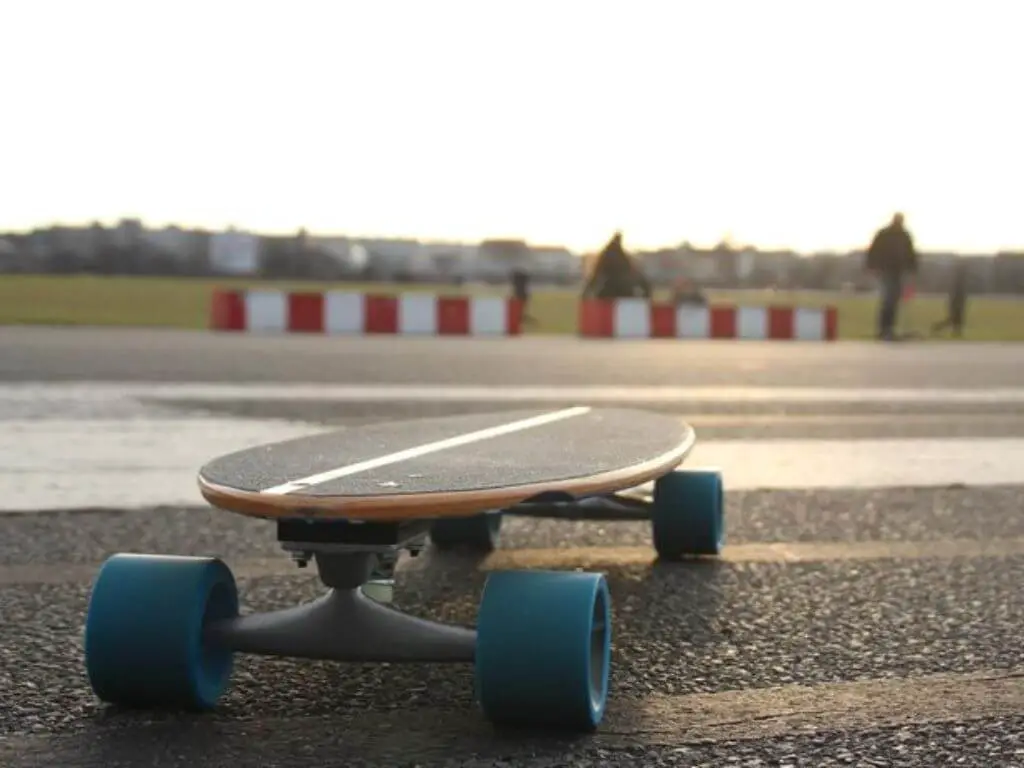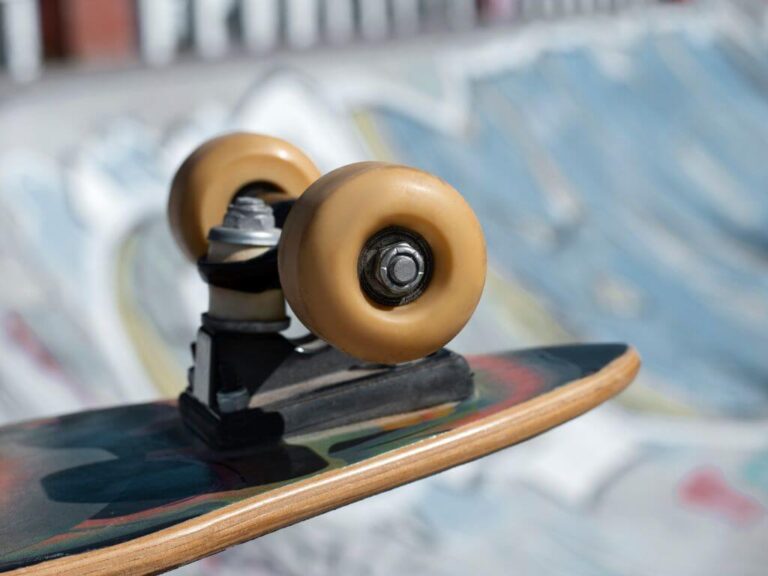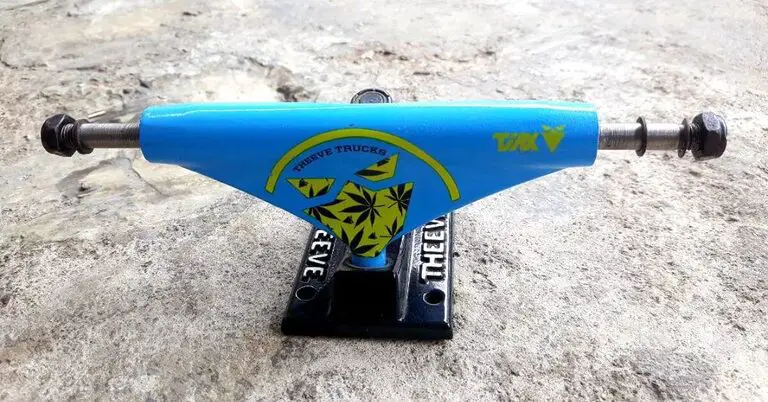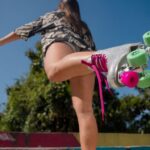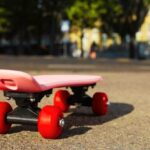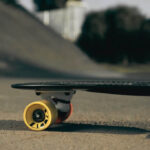If you’ve ever wondered, what are trucks on skateboards?, you’re not alone. These essential components are the backbone of every skateboard, playing a crucial role in how your board performs, turns, and feels beneath your feet. Whether you’re a seasoned skater or just starting out, understanding skateboard trucks is key to unlocking a smoother, more controlled ride.
In this ultimate guide, we’ll dive into everything you need to know about skateboard trucks—from their basic anatomy to how they impact your skating experience. Let’s roll in and explore the world of skateboard trucks!
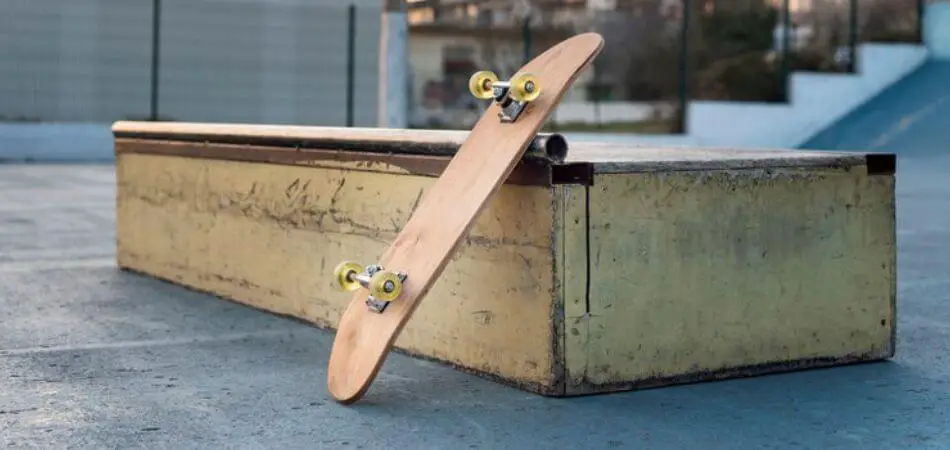
Anatomy of a Skateboard Truck
Now that you know skateboard trucks are the backbone of a skateboard’s performance, let’s get acquainted with the key parts that make them tick. Imagine a skateboard truck as a T-shaped metal friend with a few crucial components working together:
- Baseplate: This sturdy metal plate acts as the foundation, securely bolted to the underside of your skateboard deck. It’s the base camp for the rest of the truck’s crew.
- Hanger: This T-shaped section is where the action happens. It extends downwards from the baseplate and holds the wheels in place through the axle that runs through its center. Think of it as the arms and hands of the truck, always ready to grip the wheels.
- Kingpin and Bushings: This dynamic duo is the secret sauce of turning. The kingpin is a central bolt that connects the baseplate and hanger. Surrounding the kingpin are the bushings, which are like little cushions made of urethane. Tightening or loosening the kingpin nut compresses these bushings, affecting how much the hanger can turn – tighter bushings mean less turning for stability, while looser bushings allow for sharper turns.
- Axle and Wheels: The axle is a metal rod that runs through the hanger, holding your skateboard’s wheels and bearings in place. This simple yet vital part allows the wheels to spin freely, keeping you rolling.
Imagine these parts working together! The baseplate provides a solid connection to the deck, the hanger holds the wheels, and the kingpin and bushings control the turning action through the axle. Pretty cool, right?
Functions of a Skateboard Truck: Turning, Stability & More
We’ve met the crew, but what exactly do they do? Skateboard trucks are the masterminds behind several key functions that make skateboarding possible:
- Turning: Remember the kingpin and bushing duo? They’re the stars of the turning show. By leaning your body weight on the board, you put pressure on the trucks, compressing the bushings. This allows the hanger to turn slightly in the direction you’re leaning, making the board turn with you. Tightening the kingpin nut compresses the bushings more, making turns less responsive but offering more stability. Looser bushings allow for sharper turns but might feel less stable at high speeds.
- Stability: Trucks play a crucial role in keeping you balanced on your board. The width of the trucks (measured from axle to axle) contributes to the overall stability. Wider trucks provide a larger base, making it harder to tip over, while narrower trucks offer more agility for tricks. Truck height also plays a part – lower trucks offer more stability for grinding and vert skating, while higher trucks allow for sharper turns and quicker response times.
- Grinds and Tricks (Bonus): Not all trucks are created equal! Some trucks, particularly those with reverse kingpin designs, are specifically built for the demands of vert skating and grinding. These trucks often have a wider hanger base for better stability when grinding on curbs or rails.
By understanding how trucks function, you can start to see how they influence your entire skateboarding experience. From carving smooth lines to landing those epic tricks, trucks are the silent partners making it all happen.
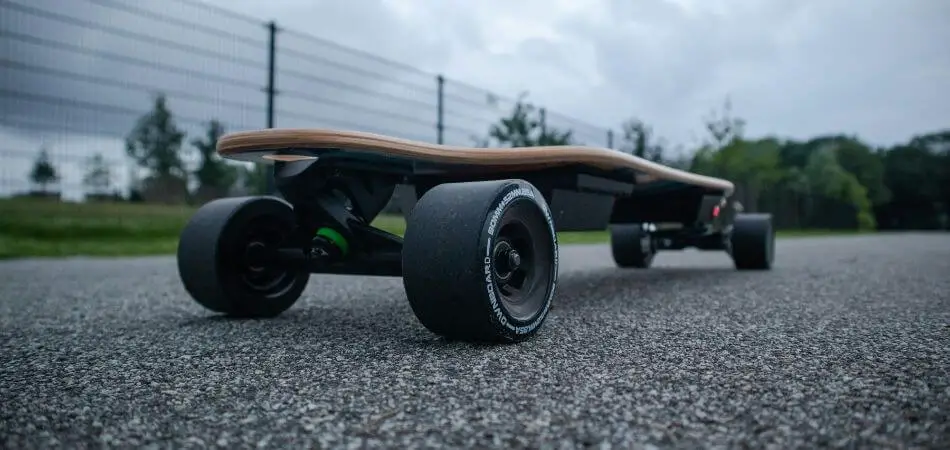
Choosing the Right Trucks For Your Riding Style
Now that you’ve unlocked the secrets of skateboard trucks, it’s time to put that knowledge to good use! Choosing the right trucks depends on several factors, and understanding these will help you customize your setup for the perfect ride:
- Skateboard Size and Deck Width: Trucks should generally match the width of your deck for optimal performance. Wider decks require wider trucks for stability, while narrower decks can work with slightly narrower trucks for better turning.
- Riding Style: Different styles demand different truck setups. Here’s a quick guide:
- Street Skating: Look for mid- or low-profile trucks for stability when grinding and popping tricks.
- Vert Skating: Opt for higher trucks with wider hangers to handle the demands of ramps and transitions.
- Cruising: Mid-profile trucks offer a good balance between stability and responsiveness for laid-back cruising.
- Wheel Size: Consider wheel size in relation to truck height to avoid wheelbite (wheels rubbing against the deck). Larger wheels might require higher trucks for proper clearance.
- Rider Weight and Experience Level: Heavier riders might benefit from stronger and wider trucks for better support. Beginners might prefer a more stable setup with slightly wider trucks or tighter bushings.
Remember, this is just a starting point! Experimenting with different truck setups is part of the fun of skateboarding. As you develop your skills and preferences, you can fine-tune your truck setup to perfectly match your riding style.
Taking Care of Your Trucks: Maintenance for a Smooth Ride
Just like any hardworking piece of equipment, your skateboard trucks require some occasional TLC to keep them performing at their best. Here are some basic maintenance tips:
- Tighten Your Bolts Regularly: Over time, the vibrations from riding can loosen the bolts that hold your trucks to the deck and the kingpin nut. Regularly check these bolts and tighten them with a skate tool to ensure a secure and safe ride.
- Keep an Eye on Your Bushings: Bushings are the workhorses of your trucks, absorbing impact and allowing for turning. However, they wear down over time, becoming harder and less responsive. If you notice your turns feeling sluggish or unresponsive, it might be time to replace your bushings.
- Clean Your Bearings (Optional): While not directly related to the trucks themselves, keeping your bearings clean and well-lubricated will significantly impact your board’s overall roll and maneuverability. Regularly remove your wheels and clean the bearings with a degreaser and fresh lubricant.
By following these simple maintenance tips, you can ensure your trucks stay in top shape, keeping your skateboard rolling smoothly and responding flawlessly to your every command.
Conclusion
So there you have it! From their anatomy and functions to choosing the right set and keeping them maintained, you’re now equipped with a solid understanding of skateboard trucks. These unsung heroes are the foundation that allows you to carve lines, launch into epic tricks, and experience the pure joy of skateboarding.
Remember, the perfect truck setup is a journey, not a destination. As you explore different styles and refine your skills, experiment with various truck configurations to find what feels best for you. With the right trucks under your feet, the world becomes your skatepark, ready to be explored with confidence and creativity.
Frequently Asked Questions About Skateboard Trucks
Q1# What are skateboard trucks?
Skateboard trucks are the T-shaped metal components that attach to the underside of your deck and hold your wheels. They’re crucial for turning, stability, and overall performance.
Q2# What are the different parts of a skateboard truck?
A truck is made up of a baseplate (connects to the deck), hanger (holds the wheels), kingpin and bushings (allow turning), and axle (holds the wheels and bearings).
Q3# How do trucks affect how a skateboard rides?
Trucks impact turning, stability, and wheel bite. Tightness, width, and height of the trucks all play a role in how your board feels and performs.
Q4# How do I choose the right skateboard trucks?
Consider your riding style (street, park, vert), deck size, wheel size, and weight when selecting trucks. Wider trucks offer more stability, while lower trucks might be better for grinds.
Q5# How do I maintain my skateboard trucks?
Regularly tighten the bolts on your trucks and kingpin nut. Replace bushings when they wear down for optimal turning. Keeping your bearings clean and lubricated also helps!
Q6# Are there different types of skateboard trucks?
Yes! Besides standard kingpin trucks, there are reverse kingpin trucks for downhill skating and Carver C trucks for a surfy, flowy ride.

